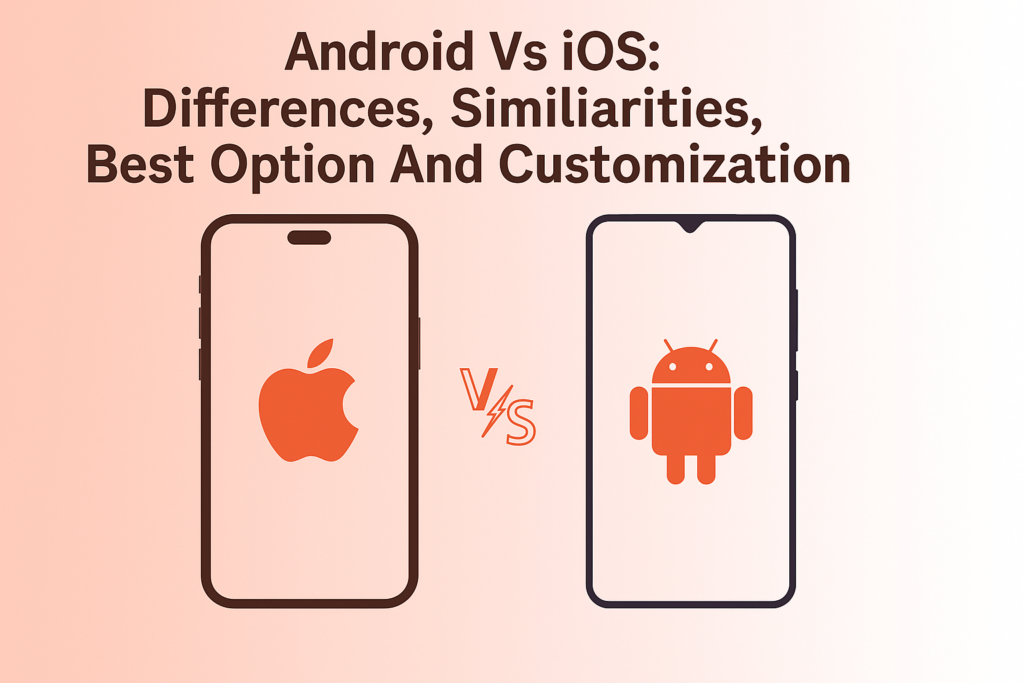The mobile app development market is experiencing significant growth and is projected to generate USD 1,095.9 billion in revenue by 2027.
While the forecast is promising, businesses need to be careful during the development process, as mobile app development can be costly.
Poor decisions in this area can lead to financial strain.
Therefore, businesses must make informed choices when deciding between native and hybrid app development.
Each has its pros and cons that can impact your resources, time, and effort.
This article will delve into the advantages and disadvantages of both native and hybrid apps.
By the end of this discussion, you will have a clearer understanding of which approach aligns best with your project goals and requirements.
Native App Development
Native mobile app development means creating an application for a specific operating system (OS) like Android or iOS.
The app is built separately for each OS using the platform-specific programming language and tools, such as Java or Kotlin as a tech stack for Android apps and Objective-C or Swift for iOS apps.
Advantages of Native App Development
This section will explore the benefits of creating a native app – the reasons that make this an attractive choice for developers wanting a high-performance application.
Optimized Performance
With specific languages and tools for each platform, developers can use the full capabilities of the device’s hardware and software.
Native apps can take advantage of hardware acceleration, multithreading, and other optimizations provided by the platform, helping improve Android app performance or whatever OS you choose.
Furthermore, native apps have a lower overhead than hybrid app development because they don’t need additional layers of abstraction and interpretation.
Meaning, native apps consume fewer system resources and have a lower memory footprint, leading to improved battery life and reduced strain on the device’s CPU and GPU.
Access to Device Features
Native apps can fully access device functionalities, such as cameras, GPS, and push notifications.
This enables developers to create more rich features of Android applications that can fully use the device’s capabilities.
For example, native app developers with access to device sensors such as GPS, accelerometer, gyroscope, and magnetometer can provide location-based services and motion tracking.
Then, they can build innovative applications like fitness trackers, navigation systems, and augmented reality experiences that use the sensors.
Furthermore, native apps with functionalities like in-app purchases and biometric authentication can offer secure payment processing and fingerprint scanning, improving the user experience and security.
Better User Experience
Following a specific platform’s design guidelines and standards, such as Material Design for Android and Human Interface Guidelines for iOS, native apps ensure familiarity for the targeted users.
The platform compatibility will result in a more intuitive and enjoyable interaction.
Native apps can also use platform-specific widgets, controls, and navigation patterns for a seamless interface.
Offline Functionality
Unlike a hybrid application that only works well with an internet connection, native apps can store data locally on the device, allowing users to access content and features even offline or with limited connectivity.
The offline functionality is crucial for apps that need continuous access to data or need to work in remote areas with poor networks.
Some cases that can use offline functionality include:
- Offline access to content. Interact with media like images and videos offline as native apps can cache and store content locally.
- Offline data synchronization. Access and update documents even when you’re offline with changes being automatically synchronized once a connection is restored.
- Offline app functionality. An example is a productivity app that lets users add a to-do list offline and sync to the cloud when a network connection is available.
- Offline gaming. Developers can provide offline gameplay modes with native apps, such as offline multiplayer modes, and access to locally stored game content.
Enhanced Security
Regarding a hybrid app vs native app in terms of security, native apps are typically more secure.
Native apps go through stricter review processes and security measures imposed by app stores.
The review process includes checks for security vulnerabilities, malware, and compliance with platform-specific policies.
Additionally, native apps can use built-in security features provided by the OS, such as sandboxing and encryption, to protect user data and prevent unauthorized access.
Limitations of Native App Development
While native app development comes with numerous advantages, it also has limitations that developers need to consider.
Limited Reach
Native apps are limited only to the platforms they’re built for, which can restrict their reach to a specific audience.
For instance, a native app for iOS will only be visible for iOS devices, excluding Android and Windows.
Yes, businesses can build two apps for separate platforms for better reach, but it will require a longer development time and a higher cost.
Longer Development Time
Developing separate app versions for different platforms can make the development cycles longer than hybrid app development approaches.
Each platform requires unique implementation and testing, which can extend the time to market for native apps.
Higher Development Costs
As native apps are built using platform-specific languages and tools, they tend to be more expensive than hybrid app development.
Businesses need to invest in developers for different platforms.
Also, the cost can increase due to a longer development, maintenance, and update time.
Real-World Examples of Native App Development
For your inspiration, here is a list of native apps in different fields:
- Uber. It’s a native app that uses platform-specific GPS capabilities to provide real-time location tracking and mapping features.
- Instagram. Instagram uses native app benefits to access particular features, such as camera access, push notifications, and location services.
- Netflix. The mobile app version uses specific APIs from different OS to implement video streaming, offline downloads, and user authentication.
Hybrid App Development
Hybrid app development is building an app that can run on multiple platforms.
It typically uses frameworks like React Native and Ionic because they’re suitable for cross-platform development.
Developers only need to write the code once and deploy it across operating systems.
Hybrid apps can also involve web technologies including HTML, CSS, and JavaScript as they’re universally supported on different platforms and devices.
Advantages of Hybrid App Development
There are several reasons many developers opt for hybrid apps.
Cross-Platform Compatibility
One of the primary benefits of hybrid app development is the use of a single codebase for multiple platforms.
Developers can write code with web technologies and some Android app development frameworks that work across platforms, reducing complexity if you plan to build an app for several operating systems.
Supporting multiple platforms, hybrid apps can also reach a broader audience across different devices and OS.
The broad reach helps enhances the app’s visibility in app stores, increasing the chances of attracting new users.
Improved Developer Productivity
Hybrid app development allows developers to use their web development skills, such as HTML, CSS, and JavaScript.
The use of these technologies will reduce the learning curve for new programming languages and help them transition more smoothly into hybrid app development.
This familiarity also enables developers to be more productive and efficient in building and maintaining hybrid apps, leading to faster development cycles and lower development costs.
Cost-Effectiveness
A lower learning curve in hybrid app development translates into cost savings.
With developers using existing web development skills, businesses don’t need to invest in specialized training, hiring additional resources, and onboarding new team members.
Frameworks used for hybrid app development also offer pre-built items and plugins, reducing the need for custom development that is often costly.
Additionally, businesses can bring their app to market sooner and start making revenue more quickly than native app development since hybrid app reduces the development time.
Faster Development Time
If you want to market your app faster, consider hybrid app development to speed up the Android development process or other OS timeline.
Hybrid app allows simultaneous development and deployment across platforms.
Developers can build and test the app once and then deploy it across different platforms, reducing development cycles.
With frameworks like React Native and Ionic, developers can use their built-in tools and components to even fasten the process.
These frameworks have pre-built UI components, plugins, and libraries for common functionalities, so developers can quickly prototype, iterate, and test their app ideas.
Simplified Maintenance
With the single codebase, developers won’t need to maintain separate ones for each platform, reducing the complexity of managing multiple app versions.
Additionally, this approach enables developers to make updates or changes centrally and deploy them across all platforms at the same time, helping them jump in trends in Android app development or iOS features quickly.
The agility also allows developers to respond quickly to user feedback and bugs when they arise.
For more informed decisions in feature development, consider checking the history of Android versions or other platforms.
Limitations of Hybrid App Development
Here are some of the key limitations of hybrid app development compared to the native app benefits.
Slower Performance
Hybrid apps often suffer from performance issues compared to native apps, particularly when it comes to rendering complex UI elements, animations, and transitions.
The challenge happens because hybrid apps run within a web view container.
As a result, they may not perform as smoothly as native apps, especially on older devices or devices with limited processing power.
Limited Access to Native Features
If you compare a native vs hybrid app, you might notice that hybrid apps have more limited access to device features than native apps.
While a hybrid app framework like Apache Cordova provides plugins for accessing common device features such as camera and GPS, they may not offer the same level of performance as native APIs.
The lower functionality can limit hybrid apps’ ability to deliver a rich experience.
Harder Debugging and Testing
Debugging and testing hybrid apps can be more challenging compared to native apps.
Developers need to account for differences in how the app behaves across different platforms while having one codebase.
Additionally, debugging tools and performance profiling may be less robust for hybrid apps compared to native apps, making it harder to identify and fix issues during development.
Real-World Examples of Hybrid App Development
Below are three successful examples of popular hybrid apps:
- NerdWallet. With its “website-first” image, NerdWallet chose hybrid app development to help the team reduce friction and time spent in the transition.
- Microsoft Teams. Microsoft built this hybrid app in React Native to provide a business conversation tool that works across platforms and devices.
- Evernote. This hybrid note app offers automatic data synchronization, note sharing, and camera scanning. It also has a great security system with TOTP, firewalls, and a Google Authenticator app.
Factors to Consider When Choosing Between Native and Hybrid Approaches
Here are several factors to consider when deciding between native and hybrid app development approaches to ensure the best fit for your project:
- Performance requirements. If your app needs to use platform-specific features like advanced camera functionalities or AR capabilities, native development will provide better access.
- Development time and cost. Hybrid development allows for quicker development and reduced costs with a single codebase for multiple platforms, but native development may provide a smoother user experience, which could require additional time and resources.
- Offline functionality. If your app needs robust offline capabilities, native apps can offer a better experience.
- Development team expertise. Understand the skill set and expertise of your development team. A team equipped with web technologies can choose hybrid app development for a smoother transition, while a team should pick native development if they’re proficient in languages like Swift or Kotlin.
Conclusion
The decision between native and hybrid app development is not a one-size-fits-all scenario.
Each approach has its strengths and weaknesses.
The right choice will depend on various factors, such as performance requirements, development time and cost constraints, and development team skills.
To conclude this native and hybrid app review, pick the first one if full access to device features, fast performance, and offline functionality are your priorities.
If a faster development process and simpler maintenance are key, the hybrid app will be an excellent choice.
In addition to understanding the pros and cons of a native and hybrid app, having the right expertise to develop your mobile application is important.
Intelivita as a trustworthy mobile app development agency will help you maximize the benefits of Android applications or other platforms you’re working on, whether you choose a native or hybrid approach.
Get in touch with our team to talk about iOS or Android app development services tailored to your specific needs!




